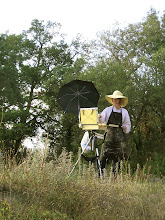How Do You Know When it is Done?????

"Fog LIfting." work in progress...
Many of my students as well as collectors often ask me how do I know when a painting is done? There is no hard and fast rule or quick answer to this question. Finishing a painting is a process, not an end in itself. Here are some suggestions on how to create a visual check list for yourself in order to determine when to put the brush down.
1. Take Breaks. Let a piece sit between painting sessions for a day or so and then come back and look at it with a fresh eye. You will be able to see things about the piece that you did not notice during your previous painting session.
2. Trust Yourself. Draw upon your inner wisdom and listen to what the painting tells you. I encourage my students to have more confidence in that intuitive sense that comes from being an artist. Stand back, and many times you will hear the painting say "more yellow," less blue," "too dark," "values too close together," "too chromatic." If the painting is still communicating what it "needs," then you are not done. The dialogue must quiet in order to be able to sign your name.
3. Don't Rush. Hurrying up just to finish is never an end in itself. If you are painting wildly to capture the fleeting light streaming across a field or the last rays of daylight, then painting succinctly is needed. However, if you are rushing just to finish, to feel "done," then you are setting yourself up for disappointment. I like to remind my students of how much a task master John Singer Sargent was when he began a portrait session. He would often stand and stare at the canvas for hours, and then produce a mere stroke. Sargent was known for rubbing out a day's work if he was not satisfied with the result.
4. Know when to let go. Don't hang on to a bad start and try to make it "turn out." We don't all come out of the gate in stride every day. Be aware of this and allow yourself a fresh start if need be.
5. It Will Never be Perfect. Understand that there will always be something about a painting you could change or do differently. Allow your individual painting efforts to stand on their own. Each painting is a stepping stone to the next one. Think of your work as a string of jewels all linked together. If you continually rework and rework, instead of moving on to the next piece, then you miss out on the experience that painting gives you.
6. Move On. Don't wallow. Don't muddle. If you find yourself chasing the light, the color getting overly muddy, put the brush down. Move on to the next canvas.
7. Appreciate Your Efforts. Knowing that you have made a big jump in your work, mastered a technical challenge or noodled out a difficult composition is reason enough to sign your name.
8. Be Compassionate. Have patience with yourself and the process of creating. Taking pride in your work and what you create is key to knowing when to allow a painting to stand on its' own.
9. Let Your Ego Go. Be open to the comments of others whose work and opinions you trust. Constructive input is integral to the artistic process and one that will help you look critically at your own work.
10. Don't Settle. Always put forth your strongest effort. When you sign your name you are saying this is my art, this is my creation. Are you ready to sign your name?








No comments:
Post a Comment